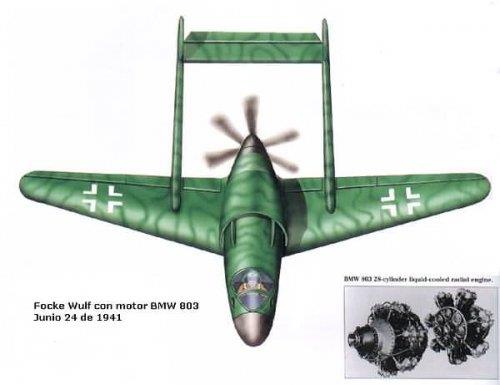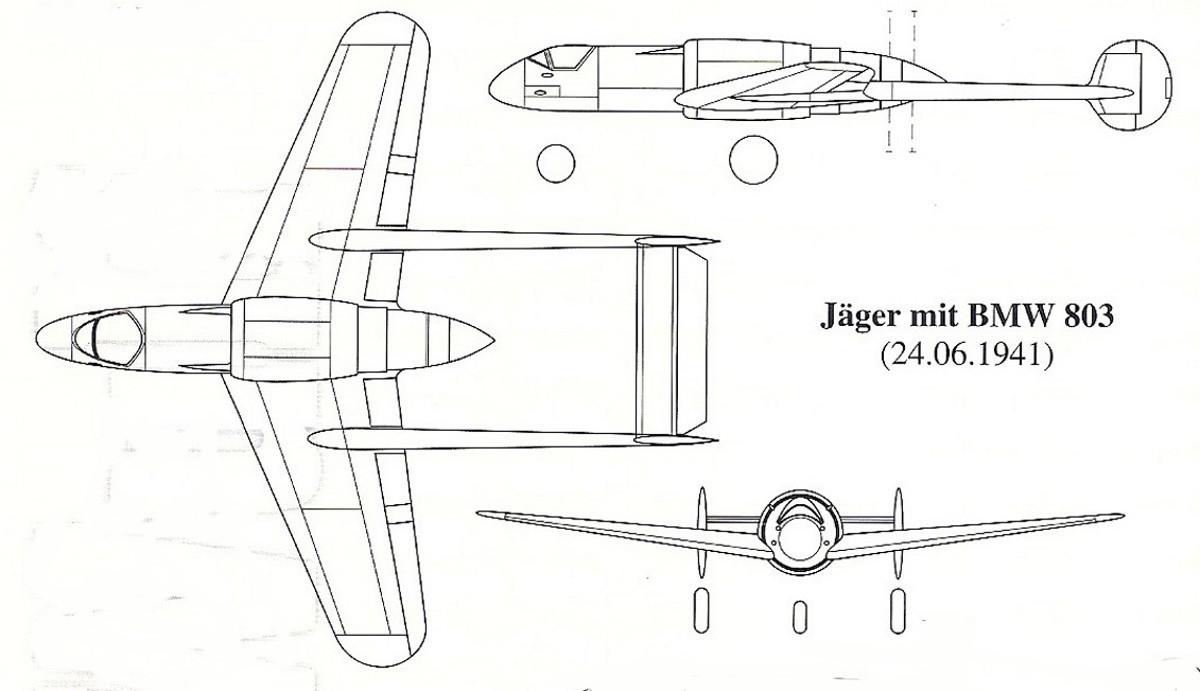| Type |
Single seat foghter |
| Engine |
1 BMW 803 |
| Dimensions |
Length 13,8 m , height , span 13,2 m , wing area , |
| Weights |
Empty , loaded , max. take off weight |
| Performance |
Max.. speed , cruising speed , range , endurance , service ceiling , climb |
| Armament |
2 MK 103 30mm cannon and 2 MG 151/20 20mm |
Even before the excelient Focke-Wulf Fw 190 single-seat, single-engine fighter entered the war for Germany in World War 2 (1939-1945), company engineers were already
hard at work at squeezing every ounce of power out of the design - with a focus on improving high-altitude performance. This led to a series of fighter design studies that ran
throughout the war years, resulting in the Fw 190 airframe being considered with various powerplant installations including the BMW 802 radial. One of the more offbeat
approaches by the concern became a twin-boom monoplane which was to sit its single pilot at the extreme front end of the fuselage and have a BMW 803 series radial
engine at rear driving a pair of propeller units in "pusher" arrangement.
The aircraft owed some of its layout to the earlier Focke-Wulf Fw 189 Uhu ("Owl") of 1940 in its selection of twin-boom configuration with a similarly-shaped monoplane
wing in which the leading edges were noticeably swept back against a relatively straight trailing edge. Instead of the Uhu's engines being fitted at the front end of each boom,
the single BMW 803 was to be buried within the confines of the fuselage directly aft of the cockpit. The propulsion scheme would draw air through a slim circular intake
design wrapping over and under the fuselage. A tricycle landing gear arrangement would provide the needed ground-running capability and was wholly-retractable - the main
legs under the boom sections and the nose leg under the cockpit floor.
The pilot sat under a largely unobstructed canopy with excelient vision out over the short nosecone (views to his rear would restricted due to the raised dorsal spine and
engine placement). As the nose was clear of any engine/propeller mounting, this gave relatively unfettered firing access to the proposed armament of 4 x 20mm MG 151
automatic cannons with two guns seated to either side of the cockpit walls. The firepower from a single burst would have been enough to bring down an Allied bomber of the
day.
In addition to this, engineers also added future support for larger caliber cannons (presumably the German 30mm type) in place of the 20mm weapons and up to four
machine guns at the wing roots (two guns per wing root).
For ground attack sorties, provision was given for the carrying of 2 x Conventional drop bombs, mounted under each boom. In lieu of this, the
aircraft could also be equipped with jettisonable fuel drop tanks for extended operational ranges.
The fighter was to have an empty weight of 14,000lb with its Maximum Take-Off Weight (MTOW) reaching 16,5351b when fully-laden. Dimensions included a running length
of 45.2 feet, a wingspan of 43.3 feet, and height of 10.5 feet.
The engine of choice was the BMW 803 28-cylinder, four-row series radial outputting 4,000 horsepower and this would be used to drive 2 x Three-bladed propeller units in
contra-rotating fashion behind the fuselage (giving the appearance of a six-bladed unit). The BMW 803 was actually a mating of two BMW 801 engines seated back-to-back.
As the heat generated from such a pairing proved substantial, liquid-cooling was employed to keep temperatures in check.
Despite the awesome power on paper, the engine did not evolve into a production-quality form. Just twelve prototypes were built during the war.
Estimated performance figures with the BMW 803 installed in the proposed Focke-Wulf fighter design included a maximum speed of 455 miles-per-hour at nearly 30,000
feet with a service ceiling of 36,750 feet possible. Range was out to a useful 1,000 kilometers.
As impressive at it may have appeared on paper, the Fw BMW803 design did not extend beyond the paper stage. Some modifications of the aircraft were made in 1943,
primarily to the cooling system, but the project fell to naught. It does, however, appear to have influenced the jet-and-rocket-powered Fw P.VII "Flitzer" fighter proposal of
1944 (detailed elsewhere on this site) - which also came to nothing.
A second iteration of the same Focke-Wulf BMW803-based design installed an oversized "drum" style radiator at the nose. This version also had a planned ejection seat. A
third design choice saw radiators fitted to the heads of the boom assemblies.





